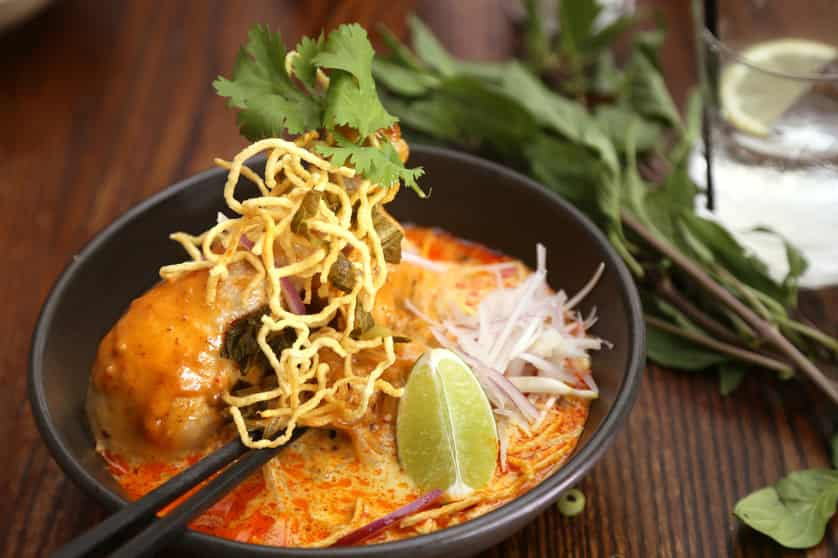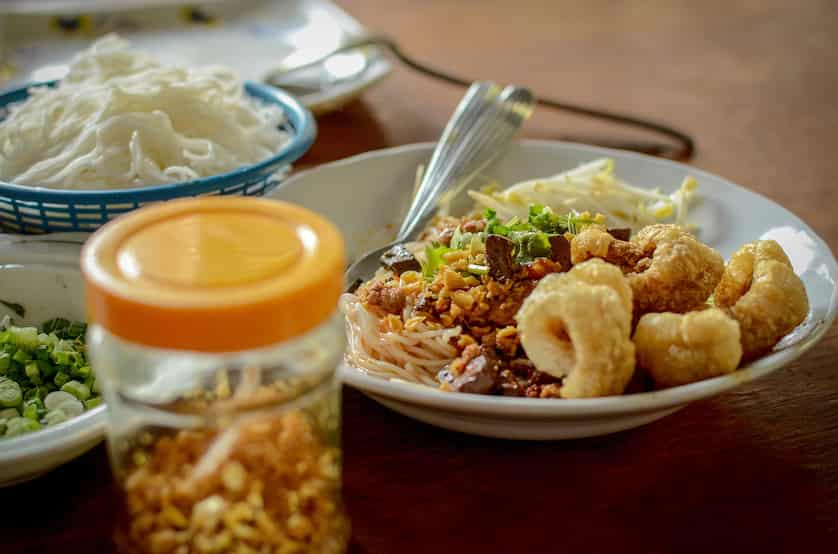Growing up in the city of Chiang Mai and being raised in a Thai-Chinese family, my knowledge of northern Lanna food was surprisingly limited. Two dishes I knew well were Northern sausages (sai-ua) and green chili paste (nam prik num), both of which were always too spicy to be appreciated by my young palate. To compound the unwelcomed burst of spice and strong smell, neither looked very appetising. As a result, I grew up with zero interest in going near either of them, let alone eating them.
My mother came from a rural part of Phare and despite being raised with authentic local dishes, she didn’t get to cook so often. It was only later, after marrying my Thai-Chinese father in 1974, that she learned how to cook Thai-Chinese dishes, feeding her husband and four Thai-Chinese children. As a family, we eat steamed rice most of the time, the Thai-Chinese way. As with most urban families, we buy our ingredients from the market instead of growing them in our gardens. Frenetic city life means that it was just easier that way. For breakfasts, we eat either rice congee with pork, fish or stir-fried dishes of veggie and rice. Sticky rice is also common in the house but it’s easier to buy than cook, in spite of my mother’s fondness for the rice cooker, after growing up without one in rural Phrae. All of us grew up with a mixture of culture and cuisine, a bit of Chinese, a bit of Thai, a bit of Lanna.
I wasn’t completely oblivious, however, and I did notice on our rare returns to Phrae for school breaks that the food there was always much different. I attributed it to being local and basic. Apart from knowing that they ate what was available – plucking everything edible within reach, whether vegetables, herbs, or the eggs from the free-roaming chicken they raised, eating frogs caught from their ponds and ants eggs harvested from the nearby mango tree – I didn’t have much knowledge of the cuisine beyond that observation. It was only much later when I learned that that was the true core of authentic northern cuisine, one that is more rich, complex and diverse than I had imagined as a child; fresh, sustainable and seasonal. When I spent my years living in the US and being away from home, I began to yearn for those tastes. Simple food like sticky rice with grilled pork liver on a bamboo stick or a small fried mackerel had me salivating more than any western dish I knew.
It was only when I moved back to Chiang Mai that I started to learn more about our cuisine and develop a taste for many dishes I had never tried before – buffalo skin, grilled pigs’ brain, pigs’ blood steamed in rice – each dish unique and ultimately delicious. I also learned that each dish also has its own local stamp; Chiang Mai’s dishes are slightly different from Lampang’s and Lampang’s dishes are slightly different from Lamphun’s, depending on local and seasonal ingredients and other local variations such as cooking tools and methods. Variables aren’t just provincial in scale, each dish can differ from district to district, even village to village. I feel as though I am having an adventure, learning and discovering the foodscape and cuisine culture of my hometown and heritage for the first time. And now that I am converted, I’d like to spread the gospel, the intricacies, and the beauty of it.
People come to Chiang Mai to sample our famous khao soy noodle curries or nam prik num…often never expanding their palates any further. Many residents have lived here for years, maybe decades, without having explored some of the less appealing looking dishes, the weird pastes, the yucky looking dips sold ubiquitously in local markets.
Bangkok Thais seem to have a go-to list of northern dishes to try, hardly ever veering off the well-eaten track.
What I have discovered is that learning about authentic food is also learning about the authentic culture and learning about authentic culture is essential for anyone visiting any place. Here’s some reason why authentic northern Thai food is worth a chance, or in some cases like mine, a deeper exploration.

Northern food is healthy
Many pastes consist of a cooked vegetable mixed with fish sauce, garlic and spices. Tam makhua, is made from grilled green eggplant mashed and mixed with spices. Tam manun is made from cooked unripened jackfruit mixed with spices. Both are healthy alternatives to consuming more vegetables and less meat, which is a direction everyone should be going towards in 2020.
Even though meat is found everywhere these days, traditionally, northerners were not great meat eaters. Most dishes in days of old contained no meat at all, with protein coming from insects or once in a while, small animals such as free-range chicken. A vegetable paste with a handful of sticky rice was pretty much a quick go-to meal across northern Thailand for centuries. Add a soup and a rich plate of fresh or steamed vegetables and you have dinner for the whole family. Curry dishes like khao soy with coconut milk are rooted in Burmese and Yunnanese cuisines and weren’t common until much more recently.
Lanna cuisine is also a healthy vegan-friendly and gluten-free alternative for those with dietary restrictions. Although fish sauce may not be appropriate for a vegan diet, many dishes can be altered and made without.
Northern food is sustainable
With the growing monopoly of the food industry, often leaving consumers with fewer options, being able to cook dinner hunted and foraged from your backyard sounds like a dream. Many northern dishes are vegetable-based so you can easily grow it yourself. Seasonal means fresh and cheap – you eat what’s there and that should be the essence of any cuisine anywhere. Seasonal means it grows by itself and it tastes the way it’s supposed to. There is no need to import or transport food from a place far away. On top of that, it supports local farmers and vendors.
Many local dishes are simply about optimisation. Having a banana tree in your house doesn’t just mean you get to eat bananas all the time. It also means that you can make a young banana stalk soup, grill some fish in banana leaves, make a banana blossom salad, the possibilities will end with your imagination.
Looking back 70 or 90 years ago, Lanna villagers would often kill a buffalo or a pig once a year for a religious ceremony, that being the one time they would eat meat. Because of that, they learnt to optimise every part of an animal. Unlike western dishes that are often focused only on the meat or some key organs, we have dishes which use up just about every part of the animal, from the buffalo skin salad to the lip-smacking khao kan jin, pigs’ blood mixed and cooked with rice in banana leaf topped with garlic oil and grilled chili.
In spite of the tropical climate which is not conducive to storing meats, our foremothers and fathers have found a number of ways to cure and keep meat. Sai-ua sausages of pork mixed with herbs are stuffed in a cow’s intestine, all designed to preserve the meat to last longer. Jin-som is buffalo meat or pork, fermented with salt in a banana leaf, meant to be cooked later with eggs or veggies. We have these creative dishes because of our ancestors’ wit and skill to make the most out of any resources.

Learning true northern culture through food
Despite the fact that there are probably more Japanese restaurants than Lanna restaurants across the rest of Thailand, Northern food is still easy to find. My favourite is to simply go to any market first thing in the morning. The choices are endless and there are fascinating dishes everywhere, each with its own story and culture. There is a reason we eat what we eat and I find it all very interesting.
Laab dib, for example, is a dish made with raw beef or buffalo meat mixed with dry spices. This particular dish is beloved by mainly men when drinking alcohol, especially after a long hard day’s work. In moonshine shacks and roadside restaurants across the region you will see groups of men, and now women, enjoying a cold beer and some raw buffalo lab dip. Unlike most dishes, laab dib is traditionally made by men, the alcohol believed to help sterilise the meat. Laab dib’s fascinating story is therefore not just one of flavour and ingredients, but one reflecting the macho subculture of grass roots rural Thailand.
This is what makes me wake up in the morning each day. I am fascinated to learn these vignettes and stories behind our cuisine. It is often easy, with fancy international cuisines arriving in our city, to forget our own heritage, but if you too find these stories fascinating, then I recommend you dig in and start tasting.
